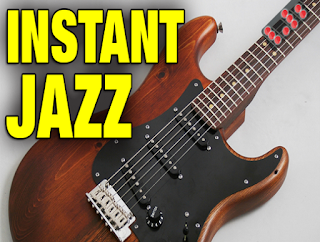Can't Play Jazz? Just Do This!
Have you ever wanted to play Jazz, guitar but you thought it was too complex and too difficult? Perhaps you've searched for a perfect scale, a scale that would help you sound jazzy - instantly? Could there possibly be such a scale? A scale that would almost immediately help with creating a jazz sound? Well, guess what - there is...
Our perfect jazz scale pattern consists of chromatic tones as well as, a color tone for connecting the scale into either major and minor sounds.
That said, just knowing this scale shape won’t make the jazz scale complete in your playing. You'll need to practice this!
In order to round out your scale use you will need to study with jam-tracks, with chord player sequences and with a looper pedal using a variety of carefully selected chord harmonies.
This work will help you start to hit every function of the scales sound and do it all in the right sequence. That is what we will be discussing in this video.
WATCH THE VIDEO:
CREATING THE JAZZ SOUND:
We’re continuing with more perfect scales in this post with a focus on the sounds that you can apply easily and quickly to promote the sound of jazz.
This scale also works well in; Soul Music, some types of Blues, in R and B, and Smooth-Jazz …basically whatever jazz style you feel like you want to try and fit this sound into - this scale should work well for you.
NOTE:
Stick with me to the end of this post, because I’ve got a really cool web-site I want to show you called “Chord Player” and it’s a great way for practicing your solos in Jazz or any style.
First, let’s begin by performing our initial jazz scale pattern on the neck. It’s a shape that functions well for both Major and Dominant chord sounds.
You can use it in Major Jazz and in some types of Blues situations. Let's try a shape based off of the root of “C” from the 5th-string, at the 2nd-fret position.
SHAPE 1).
MAJOR JAZZ SHAPE
Now that we have this scale pattern, let’s try and perform a lick over a jazz chord jam to put this particular sound into play.
Something else to remember, is when you’re trying to apply this scale at home, just let the scale and its sound do the work. Try not to over-think things.
Instead place your musical focus on phrasing ideas that you hear in your head along with using phrasing devices like; slides, vibrato, hammer-ons and pull-offs.
Those playing techniques will take you the furthest along with this sound… But, first to get you started, here’s a Minor jazz lick for you to try out. This lick is based out of this major scale pattern (shown above).
Major Jazz Scale Lick:
Next, let’s shift the sound of our Jazz Scale idea over to Minor tonality.
SHAPE 2).
MINOR JAZZ SHAPE
When it comes to the scale set-up for minor, we’re going to shift the fret-board location of the 3rd scale degree from being in the “Major 3rd” position and we’ll move it over to the “Minor 3rd” position.
If we set that up off of the same scale shape (that we played for Major), using a “C” root note off of the 5th string’s 3rd fret, we’d end up with a scale that looks like this…
As you can tell, the scale patterns for major and minor are very similar. The only real difference is the location of the scales 3rd tone.
Off of the Major scale we had an “E” natural tone. But, to create Minor, we simply lowered the 3rd from “E” Natural, down to an, “Eb.”
I want to help you apply this sound (of our new Minor Jazz scale), by organizing a melody to cover a Minor chord jam from off the root of, “C Minor.”
Minor Jazz Scale Lick:
Work with the video demonstration of this lick until it feels smooth and easy to perform. Then, work at inventing your own licks.
CONCLUSION:
In wrapping up, my suggestion is to work on generating some chord jams that apply a Jazz sounding chord harmony where you could get to work and practice these Major and Minor Jazz scales...
If you have a looper pedal, record a jam with some jazzed up chords like the; Dominant 13 or using Major 7 or the Major 9. In the Minor direction, try using chords like the Minor 11 the Minor 7, or the Minor 6 chord.
These chord sounds will function as excellent back-drops to create just the right setting for playing these jazz scales over.
If you don’t have anything to play-back chords on, I’d suggest checking out a great online chord generator that was created by “OneMotion.com,” it’s called the “Chord Player.”
Before we wrap up here, let me give you a quick tutorial on how to use this really handy online chord player…
CHORD PLAYER:
• VISIT THE WEBSITE:
If you’d like to learn more about topics like this one and many others, join my members site as a free member and start looking through my, “Guitar Courses.”
I’ve spent over 25 years working with hundreds of guitar students creating thousands of detailed step-by-step guitar lessons for both my website members and my private students.
The result is the most comprehensive guitar course that covers every aspect of beginner to advanced playing ideas to help you improve your playing.
• LIMITED TIME OFFER:
If you join my site as a Premium member, you’ll receive a FREE copy of my popular Guitar Technique eBook.
My Guitar Technique eBook is 28 pages of jam-packed exercises, drills and studies for mastering all of your technical skills at playing Guitar.
Our perfect jazz scale pattern consists of chromatic tones as well as, a color tone for connecting the scale into either major and minor sounds.
That said, just knowing this scale shape won’t make the jazz scale complete in your playing. You'll need to practice this!
In order to round out your scale use you will need to study with jam-tracks, with chord player sequences and with a looper pedal using a variety of carefully selected chord harmonies.
This work will help you start to hit every function of the scales sound and do it all in the right sequence. That is what we will be discussing in this video.
WATCH THE VIDEO:
CREATING THE JAZZ SOUND:
We’re continuing with more perfect scales in this post with a focus on the sounds that you can apply easily and quickly to promote the sound of jazz.
This scale also works well in; Soul Music, some types of Blues, in R and B, and Smooth-Jazz …basically whatever jazz style you feel like you want to try and fit this sound into - this scale should work well for you.
NOTE:
Stick with me to the end of this post, because I’ve got a really cool web-site I want to show you called “Chord Player” and it’s a great way for practicing your solos in Jazz or any style.
First, let’s begin by performing our initial jazz scale pattern on the neck. It’s a shape that functions well for both Major and Dominant chord sounds.
You can use it in Major Jazz and in some types of Blues situations. Let's try a shape based off of the root of “C” from the 5th-string, at the 2nd-fret position.
SHAPE 1).
MAJOR JAZZ SHAPE
Now that we have this scale pattern, let’s try and perform a lick over a jazz chord jam to put this particular sound into play.
Something else to remember, is when you’re trying to apply this scale at home, just let the scale and its sound do the work. Try not to over-think things.
Instead place your musical focus on phrasing ideas that you hear in your head along with using phrasing devices like; slides, vibrato, hammer-ons and pull-offs.
Those playing techniques will take you the furthest along with this sound… But, first to get you started, here’s a Minor jazz lick for you to try out. This lick is based out of this major scale pattern (shown above).
Major Jazz Scale Lick:
Next, let’s shift the sound of our Jazz Scale idea over to Minor tonality.
SHAPE 2).
MINOR JAZZ SHAPE
When it comes to the scale set-up for minor, we’re going to shift the fret-board location of the 3rd scale degree from being in the “Major 3rd” position and we’ll move it over to the “Minor 3rd” position.
If we set that up off of the same scale shape (that we played for Major), using a “C” root note off of the 5th string’s 3rd fret, we’d end up with a scale that looks like this…
As you can tell, the scale patterns for major and minor are very similar. The only real difference is the location of the scales 3rd tone.
Off of the Major scale we had an “E” natural tone. But, to create Minor, we simply lowered the 3rd from “E” Natural, down to an, “Eb.”
I want to help you apply this sound (of our new Minor Jazz scale), by organizing a melody to cover a Minor chord jam from off the root of, “C Minor.”
Minor Jazz Scale Lick:
Work with the video demonstration of this lick until it feels smooth and easy to perform. Then, work at inventing your own licks.
CONCLUSION:
In wrapping up, my suggestion is to work on generating some chord jams that apply a Jazz sounding chord harmony where you could get to work and practice these Major and Minor Jazz scales...
If you have a looper pedal, record a jam with some jazzed up chords like the; Dominant 13 or using Major 7 or the Major 9. In the Minor direction, try using chords like the Minor 11 the Minor 7, or the Minor 6 chord.
These chord sounds will function as excellent back-drops to create just the right setting for playing these jazz scales over.
If you don’t have anything to play-back chords on, I’d suggest checking out a great online chord generator that was created by “OneMotion.com,” it’s called the “Chord Player.”
Before we wrap up here, let me give you a quick tutorial on how to use this really handy online chord player…
CHORD PLAYER:
• VISIT THE WEBSITE:
If you’d like to learn more about topics like this one and many others, join my members site as a free member and start looking through my, “Guitar Courses.”
I’ve spent over 25 years working with hundreds of guitar students creating thousands of detailed step-by-step guitar lessons for both my website members and my private students.
The result is the most comprehensive guitar course that covers every aspect of beginner to advanced playing ideas to help you improve your playing.
• LIMITED TIME OFFER:
If you join my site as a Premium member, you’ll receive a FREE copy of my popular Guitar Technique eBook.
My Guitar Technique eBook is 28 pages of jam-packed exercises, drills and studies for mastering all of your technical skills at playing Guitar.
___________________________________________________
GET GOOD NOW - JOIN THE MEMBERS AREA
Guitar Chords | F Chord | Guitar Notes | G Chord | C Chord | D Chord | Guitar String Notes













